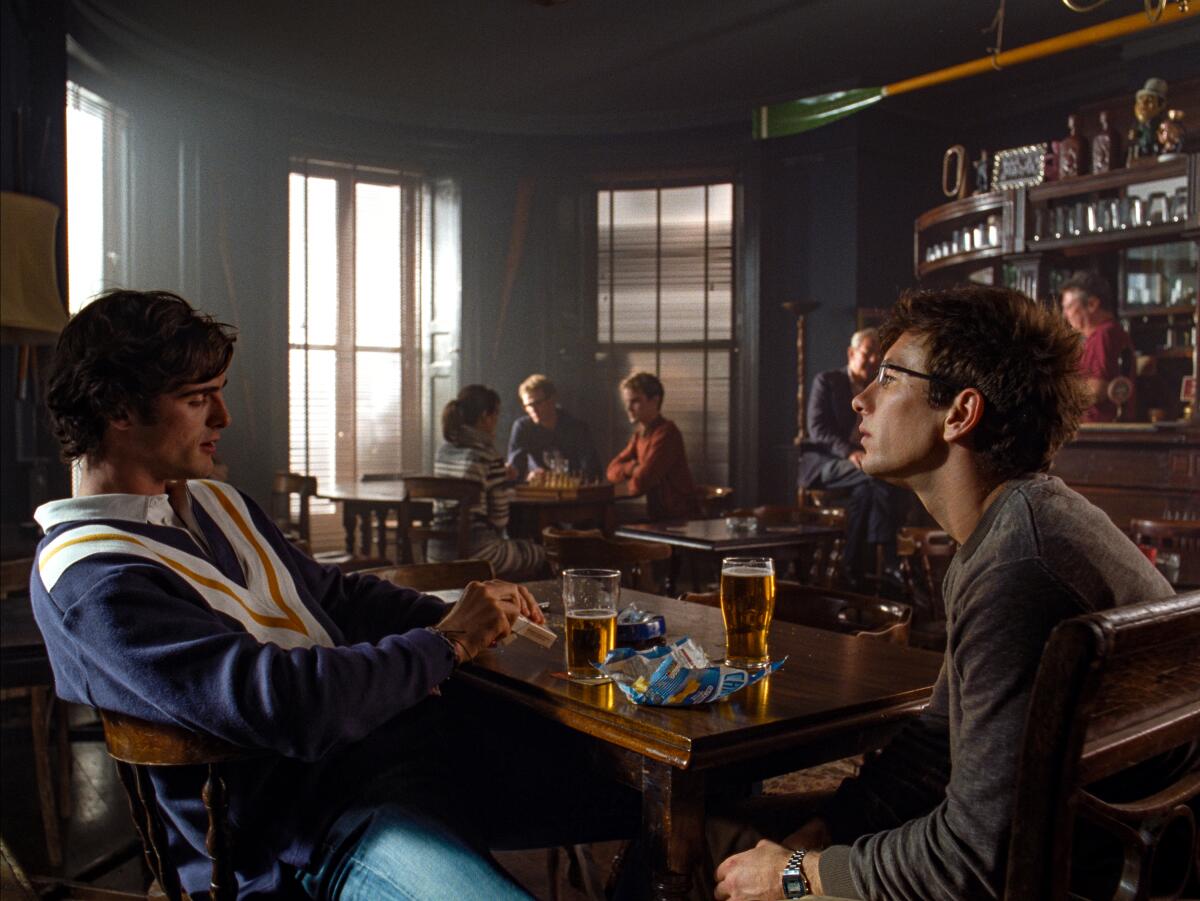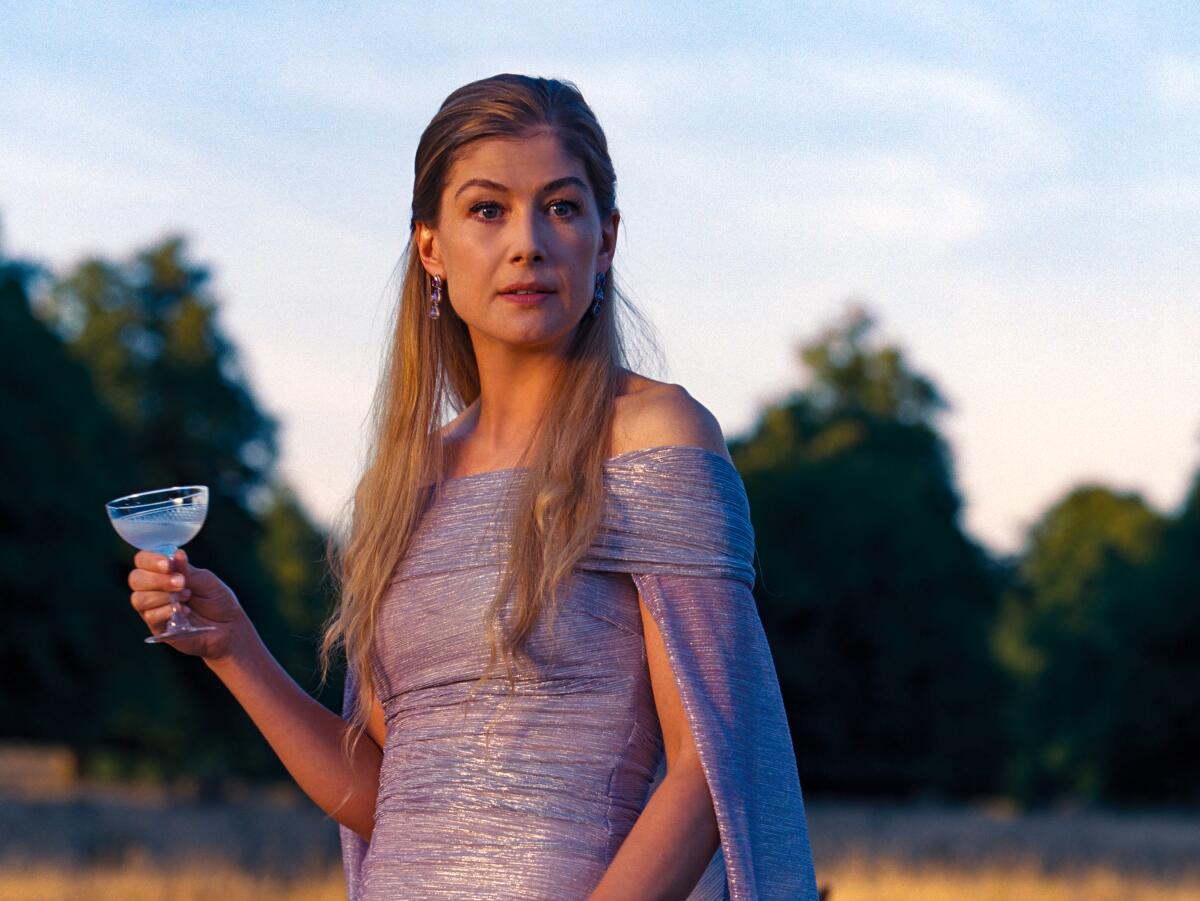Emerald Fennell has already conquered Hollywood. Now she wants to follow her ‘crushes’

- Share via
Speaking backstage at London’s Barbican Centre before an appearance, Emerald Fennell, the writer and director of 2020’s “Promising Young Woman” and now, the darkly comedic “Saltburn,” is leaning into her reputation.
“I’m not setting out to be willfully contrary, but I don’t think it’s possible to make something really good and also completely digestible,” she says. “Even the films I love from the past — the canonical, perfect films — you go back and they’re not perfect. That’s why they’re so interesting. I’ve been lucky that I’ve been allowed to make things that aren’t quite so frictionless.”
Frictionless is the last word you’d use to describe “Promising Young Woman,” which stars Carey Mulligan as a woman on a harrowing path of vengeance. Nor, despite the film’s five Oscar nominations (including a win for original screenplay), could it be applied to Fennell’s own trajectory. She had been slowly making her way up in Hollywood for more than a decade.
Fennell, 38, got her start in acting on British TV after graduating from Oxford, eventually being cast as a lead in several seasons of “Call the Midwife” and as supporting characters in movies like “Anna Karenina” and “The Danish Girl.” She was tapped by Phoebe Waller-Bridge to write the Emmy-nominated second season of “Killing Eve,” the first hint of Fennell’s darker obsessions.
But it was “Promising Young Woman,” released at the height of the #MeToo era, that fully unleashed Fennell’s filmmaking instincts.
“It was terrifying,” Fennell says, recalling that she had only two weeks prep in Los Angeles, where she’d never previously worked. “I gave birth three weeks after we finished shooting. I loved it, but it could have been a disaster.”
This was not the case. Her awards success offered an opportunity to make another unusual film with more time and more budget.
“I said quite early on to my lovely agents and manager to not send me any of the offers,” Fennell says of that post-Oscars moment. “I really felt that I wanted to make my own things for as long as anyone would let me. It was quite freeing in a way, because it gave me a lot of confidence.”
Mulligan, who also appears in the new “Saltburn” (now in limited release), believes that Fennell would have always stuck to her instincts, even if she hadn’t won an Oscar.
“She’s not in the business of making stuff as a strategic path to anything else,” Mulligan says. “She’s just a storyteller.”

“Saltburn” springs from an idea that, per Fennell, has been in her head for seven or eight years, along with many other stories she says are constantly rattling around. “It’s sort of like: How many crushes you have at any given time,” she offers.
The film follows new Oxford student Oliver Quick (Barry Keoghan), a withdrawn young man looking for connection. Oliver sidles his way in with his popular, beautiful classmate Felix (Jacob Elordi), whose aristocratic English family lives in a sprawling countryside manor named Saltburn.
When Felix invites Oliver home with him for the summer, Oliver quickly becomes transfixed by Felix’s parents, Elspeth (Rosamund Pike) and James (Richard E. Grant), and his sister Venetia (Alison Oliver). His intentions seem hazy at first, but it’s soon clear they aren’t entirely pure.
Fennell wrote the script quickly after years of working through the story internally, waiting until she’d “had every conversation, been in every room, done every configuration a million times over so it’s stopped changing,” she says.
“The more I rework something on paper, the more lifeless it gets,” Fennell explains. “It’s not until after rehearsals and after I’ve spoken to the actors that things change a bit.”
“Saltburn” came out of Fennell’s interest in making a modern Gothic in the vein of “Rebecca” or “Brideshead Revisited.” It’s a genre she describes as restrained, ripe for the revising.
“It felt like a fun thing to try and see what would happen if you completely unrestrained it and let it go,” the writer-director says. “It felt like such an interesting way to talk about longing and desire and how voracious our current wanting is for things and people.”

Mulligan plays Pamela, a quirky hanger-on of the Catton family. She begged Fennell to let her do the part, despite it being more of a cameo. The actor finds Fennell’s “crystal-clear vision” compelling.
“If she rang me up and was like, ‘Let’s make this film about trees,’ I’d be like, ‘Great,’” Mulligan says. “Because I know that it would be the craziest, pulsating yet heartbreaking film about trees. I want to work with her until I die.”
On “Saltburn,” Fennell was given complete creative freedom. Margot Robbie, whose company LuckyChap produced both “Promising Young Woman” and “Saltburn,” confirms she would have followed the director anywhere.
“She taps into those dark little crevices of your mind and plants a seed there and, as she lets her story unfold, you realize you’re somehow complicit in it,” Robbie says. “It’s quite an extraordinary trick she pulls off.”
She continues, “If you feel like you’re being coddled, watch out, because she’s probably about to rip the rug out from beneath you.”
“Saltburn” does, in fact, force the viewer to observe some squirm-inducing situations, none of them worth spoiling here. After the forced distance of the pandemic, Fennell was curious about human contact.
“All of us [were] in this weird position of just watching other people’s lives and not be able to touch them,” she says. “I wanted to make something about touching people — about sweat, about blood, about semen. There is something freeing about interrogating that feeling of consuming other people.”
There’s a tactile sense to “Saltburn.” The bodily fluids flow freely. Fennell feels you can tell a lot about a viewer by how they react to certain moments.
“The best response for this film, which some people have, is they’re quite physically shaken,” she says. “They’ve got quite a lot of adrenaline afterward. That’s when it’s really exciting. They’re like, ‘I could kill someone!’ Or, ‘I could f— someone!’”

Visually, Fennell tapped production designer Suzie Davies and Oscar-winning “La La Land” cinematographer Linus Sandgren to bring her carefully imagined tale to life. They found a privately owned estate in Northamptonshire to stand in as the fictional Saltburn and the Oxford scenes were shot on location. Reference points included the work of Alfred Hitchcock and Stanley Kubrick, Joseph Losey’s 1971 film “The Go-Between” and the paintings of Caravaggio.
“The script was very visual when I read it,” Sandgren says. “It obviously has a black humor, but also is sensual. It’s gross and beautiful and ugly at the same time.”
Sandgren shot the film in the squarish 1.33 “Academy” ratio, an unusual choice that results in a kind of on-screen claustrophobia. It also allowed Fennell to fill the frame with close-ups of faces — and, at one point, Elordi’s armpit. (She created a mood board on armpit hair, which Fennell feels is both sexy and transgressive.)
“The standard for somebody being on film is perfection,” she says. “I don’t mean like beauty perfection — I mean literally that people would just be groomed, because people wouldn’t like to see a messed eyebrow hair. But I like to see that stuff because it’s really crucial information.”
The fastidiousness is a continuation of how Fennell approached “Promising Young Woman.” To her, a chair can’t be just a chair.
“There are 100,000 chair choices in the world that you could choose, so why that one?” she says. “And how do they sit in it? And is it slightly too low, which means they kind of can’t get out of it elegantly? For me, the pleasure of watching and making films is knowing that every detail has been forensically chosen.”
Sandgren confirms his director’s precision, “but she’s also willing to compromise,” he adds. “She gives a lot of respect to everyone and, at the same time, if she feels something is important, she’s always very honest.”
Fennell has continued to act, recently as Camilla Parker Bowles on two seasons of “The Crown” and as the pregnant “Midge” doll in “Barbie.” A singular shift to filmmaking, though, is imminent. Her next movie has long been percolating.
“I need some thinking time,” Fennell says of when she would realistically begin production on the idea. She has two young children with husband Chris Vernon, who take up a lot of her time. But she’s optimistic the wait will be “not long.”
For now, Fennell is content to observe the reaction to her riotous, disquieting latest — divisive, too, but any reaction is worthwhile to her if it gets people talking.
“She doesn’t see cinema as a way to teach people,” Mulligan says. “She’s a proper artist making stuff and putting it out, and people can respond to it in any which way.”
Fennell demurs, describing herself as “such a natural, slippery” people-pleaser. “I’m so spineless,” she says. “I’ll just do anything to make people like me.”
But when it comes to making films, she says, “that’s the one place I don’t have that quality.”
More to Read
Only good movies
Get the Indie Focus newsletter, Mark Olsen's weekly guide to the world of cinema.
You may occasionally receive promotional content from the Los Angeles Times.










